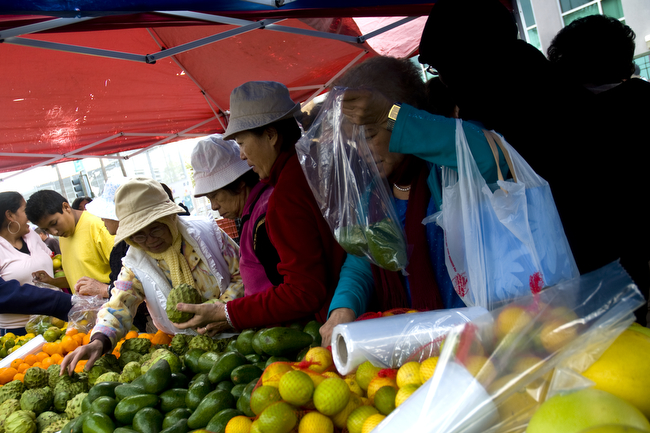 At the farmers market in City Heights, customers are able to use food stamps to purchase their fruits and vegetables. It’s a helping hand for the customers and a boon for the farmers. | Photo Credit: Sam Hodgson
At the farmers market in City Heights, customers are able to use food stamps to purchase their fruits and vegetables. It’s a helping hand for the customers and a boon for the farmers. | Photo Credit: Sam Hodgson
Local advocates for the needy have warned for years about “food deserts” in poor communities that make it difficult for some residents to find affordable fruits and vegetables. Now, there’s a dose of good news: A new study says San Diego-area low-income residents got a big boost from a government program designed to encourage healthy eating and support farmers markets in poor neighborhoods like City Heights.
Thousands of local residents who get government assistance enrolled in the program and received vouchers to buy nutritious foods like produce, meat, bread and eggs at farmers markets. The participants spent about $330,000 from 2010-2011, or about $93 per person.
There are some caveats. No one knows whether any area residents actually became healthier as a result of the program, which has dwindled from its high point of serving several communities because of funding woes. And participants are only allowed to spend the extra money at farmers markets. They can’t use it to buy food at supermarkets, chain stores like Target or Costco or corner shops.
Still, the incentive program was “definitely a success,” said Blanca Melendrez, who oversees obesity prevention programs sponsored by UCSD and helped establish the farmers market in the City Heights neighborhood in 2008.
The City Heights farmers market was unusual when it opened because it was the first in the county to accept food stamps and benefits from Social Security and the Women, Infants, and Children program.
The new study, led by researchers at San Diego State and published in the Nov. 14 issue of the journal Preventing Chronic Disease, tracked the progress of the Farmers Market Fresh Fund Incentive Program over a year. The $715,000 program, funded through two federal grants, allowed county residents to double up to $20 a month of government assistance for food (like food stamps) if they agreed to take vouchers they could use at certain farmers markets for certain types of healthier food.
A person who gets food stamps, for example, could buy vouchers to buy healthier types of food for $20 and get another $20 worth for free.
“Our goal was to empower the community to eat healthier and be active,” Melendrez said.
The study authors found that almost 7,300 people signed up for the program, which eventually expanded to farmers markets in Linda Vista, southeastern San Diego, San Marcos and Golden Hill.
In 2011, the farmers markets made $1.5 million, including $350,000 in incentives from the Fresh Fund program, Melendrez said. On average, she said, vendors made $47,000.
Could the participants have been able to find cheaper produce and other healthier foods elsewhere? Melendrez doesn’t think so. “Our goal was to work with our farmers to make sure they were offering competitive prices compared to those offered in the surrounding area, or less expensive,” she said. “Our experience is that people feel the produce we offer is affordable, fresh and culturally appropriate.”
Lisa Powell, a professor of health policy and administration at the University of Illinois, reviewed the study findings for Voice of San Diego and said the program has plenty of potential to make a difference in terms of health. “Other research has shown that lower fruit and vegetable prices are associated with lower body weight, particularly among low-income children and women,” she said.
The findings of the study offers support to the idea of testing similar programs “more broadly in supermarkets, and grocery and convenience stores,” she said.
For now, however, the federal grants for the program have run out. The International Rescue Committee offering Fresh Fund incentives in conjunction with the San Diego County Farm Bureau at the City Heights farmers market and independently at the farmers market in downtown El Cajon.
Both markets serve many refugees, said Anchi Mei, who oversees food and health issues for the local branch of the committee. The Farm Bureau and the refugee advocacy organization support the incentives with revenue from the farmers markets and other funds, she said.
However, she said, the organizations have had to limit the number of times that residents can get the incentives due to lack of funding. The only people who can take advantage of the program now are those who weren’t enrolled previously.
Meanwhile, a major cut in the food stamp program has left dozens of City Heights farmers market customers with $36 less a month to spend on food, and more cuts may be on the way. In an interview last month, the market’s manager warned that the cuts could ultimately lower proceeds for farmers and drive them away.
“Every squeeze to food budgets will be another barrier for people to buy food from the farmers markets,” Mei said.
Randy Dotinga is a freelance contributor to Voice of San Diego and vice president of the American Society of Journalists & Authors. Please contact him directly at randydotinga@gmail.com and follow him on Twitter: twitter.com/rdotinga.
